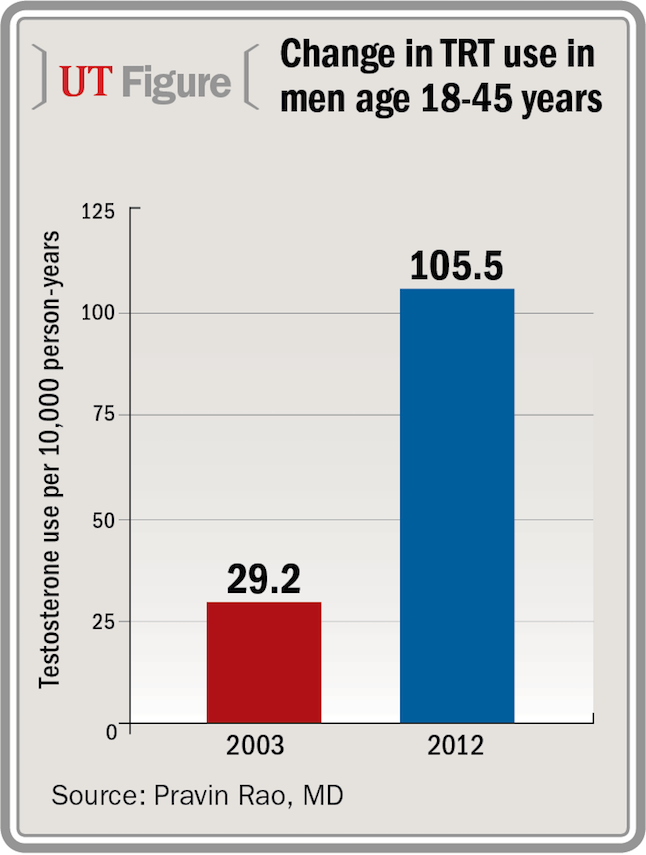Article
Testosterone use triples in younger men
Author(s):
Use of testosterone replacement therapy more than tripled between 2003 and 2012 in a population of reproductive-age men, according to a study presented at the AUA annual meeting in New Orleans.
New Orleans-Use of testosterone replacement therapy more than tripled between 2003 and 2012 in a population of reproductive-age men, according to a study presented at the AUA annual meeting in New Orleans.

Dr. Rao“Over the 10 years included in our study, there was a 3.5-fold increase in testosterone use among 18- to 45-year-old men. Notably, around 2009, we saw a sharp increase in the proportion of these men who were using injection formulations over other formulations,” said lead author Pravin Rao, MD, assistant professor of urology and director of reproductive medicine and surgery at Johns Hopkins Brady Urological Institute in Baltimore.
Read: Oral TRT agent may improve patient compliance
Given concerns about potential misuse of these medications and consequent impacts on fertility in younger men, the FDA recommends that the use of TRT should be limited to men with medical conditions causing low serum testosterone levels. However, according to Dr. Rao, there have been few studies examining the lab testing and use of TRT in reproductive-age men in the United States.
“We see a lot of young guys who might have been put on testosterone coming into our clinic, and they’re having unexpected azoospermia or infertility, so we had some concern. We were curious about how these numbers looked in the younger population and wanted to examine the trends and practice patterns as well as the use of testosterone in a younger population,” Dr. Rao said.
Data were derived from outpatient pharmaceutical and service claims data using the 2003-2012 Truven Health MarketScan Commercial Claims Databases.
Results showed that the rate of testosterone use more than tripled among 18- to 45-year-old men (from 29.2 per 10,000 in 2003 to 105.5 per 10,000 in 2012).
NEXT: Injection use doubled after 2009
More on Testosterone
What do you think of new warning labels on TRT products?
Long-term TRT study refutes concerns about prostate safetyPromoting TRT online: Balanced information lacking
Injection use doubled after 2009
Use of gel formulations, Dr. Rao noted, was most common but declined from 66.9% in 2003 to 55.3% in 2012. The proportion using injections, however, doubled after 2009 to more than 46%.
“One of the most notable findings was the sudden increase in the fraction of men who were using injection,” Dr. Rao observed.

Also noted by Dr. Rao was the percentage of users who had their testosterone level checked within a year of starting therapy, which has improved over the last 10 years.
“In 2003, around a third of men were having a lab test done a year before starting therapy. That did improve to 80% in 2012, but that still means that 20% of men may not be getting checked prior to starting therapy, which is concerning,” Dr. Rao said.
NEXT: Possible factors behind findings
According to Dr. Rao, direct-to-consumer advertising, FDA involvement with labels and warnings, patient and provider education, and considerations of cost and provider reimbursement are some of the important factors that might have led to these findings.
“While marketing might be affecting the use of testosterone, policy and patient education about the indications and potential side effects could help curb overuse and unwanted complications,” he said.
There are also plans for a follow-up study.
“Once we get more recent data, one of the fascinating things for me would be to see how things have changed, because in the last few years implants have taken off, and we want to see what this curve does,” Dr. Rao said.
One study co-author has a disclosure related to Endo and is also a meeting participant/lecturer for AbbVie. Another co-author has disclosures related to Andro 360, SpermDx, SimpleCirc, and NANONC.
More on Men's Health
TRT, blood clot risk evaluated in large analysis
Study: No significant link between diabetes Tx, bladder Ca
Upfront chemo called ‘standard’ in hormone-naïve PCa
Subscribe to Urology Times to get monthly news from the leading news source for urologists.
















